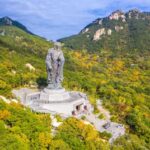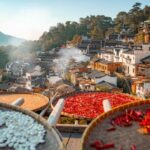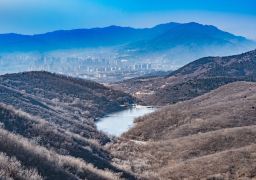Hui Ji Temple, also known as the Buddha Summit Temple, is located on the high ground of Mount Putuo and is one of the three major temples of Mount Putuo. The temple is famous for the Goddess of Mercy, known as the ‘Zhu Sheng Niang Niang’ in the Guanyin Hall, who is believed to be an effective deity for granting children. Additionally, due to its location at the summit, the platform in front of the temple is an excellent spot for viewing sunrises and sunsets.
Built in a unique style, Hui Ji Temple is constructed along the mountain, arranged horizontally, with spacious and magnificent halls nestled in the forest, renowned for its serene environment. The temple complex includes four main halls, seven halls, five pavilions, and storerooms, totaling 145 rooms. The layout of the temple adapts to the mountain, with the Mahavira Hall, the Great Compassion Hall, the Sutra Repository, the Jade Emperor Hall, and the Abbot’s Chamber all aligned on the same parallel line, embraced by the side rooms, reflecting the architectural style of Eastern Zhejiang gardens.

If you are physically fit, you may choose to hike up the mountain along the stone path embedded with lotus flowers, flanked by yellow walls, where you can witness many devout believers performing prostrations and recitations. Alternatively, you can opt for the cable car to ascend and hike down, which is more energy-efficient. Following the Xiang Yun Road, you will reach the Fayu Temple, and along the way, you can see the massive rock inscribed with ‘Sea and Sky Buddhist Kingdom’. On a clear day, you can observe the clouds encircling the mountain waist.

When visiting Hui Ji Temple, you can take photos at several small scenic spots such as the Lotus Pond, the ‘Buddha on Buddha’ wall, and the ‘Together to the Other Shore’ stone tablet. The Mahavira Hall and the Guanyin Hall are the most popular for offerings. Unlike other temples on Mount Putuo, the main hall, the Mahavira Hall, enshrines a statue of Sakyamuni Buddha, flanked by his disciples Ananda and Mahakasyapa. On both sides of the hall, there are 10 statues each, representing the ‘Twenty Heavenly Kings’ in Buddhist legends. The roof of the Mahavira Hall is entirely covered with colored glaze tiles, and if you take the cable car up the mountain, you might witness the splendid spectacle of ‘Buddha’s Light Illuminating All’ in the sunlight.

On the left side of the Mahavira Hall is the Guanyin Hall, which houses stone carvings of Guanyin based on depictions by painters throughout the ages, representing one of the essences of Putuo’s religious art. This place is also a must-visit for those who come to Mount Putuo to pray for fertility, as it is said to be very effective. When burning incense here, sincerity is key; three sticks are sufficient, and noise, smoking, photography, and lighting candles and incense are strictly prohibited inside the halls. After paying homage to the Buddha, you can visit the ‘Putuo Yarn Elm’ behind the temple’s back door, a tree brought by a Burmese monk over 200 years ago during his pilgrimage to Mount Putuo, now listed as a second-class national species and a popular sight for tourists.
For minors aged 6 to 18 years old (inclusive) or with a height of 5 meters (inclusive), holding valid identification, there are preferential policies. For the elderly: Elderly people aged 70 years old and above (inclusive) across the country, holding valid identification, are free of charge. Elderly people aged 60 to 69 years old (inclusive), holding valid identification, enjoy preferential policies. For students: Full-time students of ordinary schools (excluding evening universities, TV universities, online education, distance education, adult education, continuing education, and full-time off-campus education), holding valid identification, enjoy preferential policies. For the disabled: Holding valid identification, free of charge. For military personnel: Active-duty military personnel across the country, including armed police and disabled soldiers, holding valid identification, are free of charge. For journalists: Holding a press card issued by the General Administration of Press and Publication, free of charge. For teaching staff: Only on Teachers’ Day, holding valid identification, free of charge. For tour guides: Holding a national tour guide certificate, free of charge. For monks and nuns: Holding valid identification, free of charge. For national model workers: Holding valid identification, free of charge. For national moral models: Holding valid identification, free of charge. For retired cadres: Holding valid identification, free of charge. For families of martyrs: Holding valid identification, free of charge. Supplementary note: 1. Those who meet the reduction or exemption conditions please hold valid identification and go through the ticket check to enter the mountain. 2. The ticket for Putuo Mountain scenic area does not include the incense ticket for temples and the ticket for Luojia Mountain scenic spot. 3. The above information is for reference only. The specific information shall be subject to the disclosure of Putuo Mountain scenic area on the same day. Must-see tips: 1. If you want to walk up the mountain, it is recommended to wear comfortable shoes. 2. Try to avoid going to worship on holidays, during the Guanyin incense fair period, Guanyin Nirvana Day, and the first day of the lunar month, as there will be a large number of people at that time.









